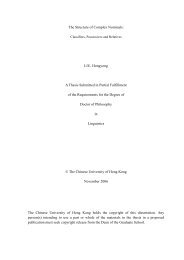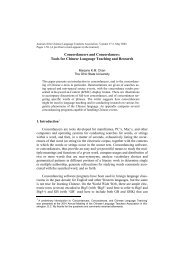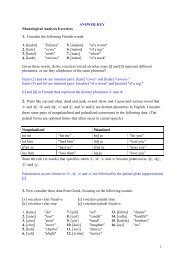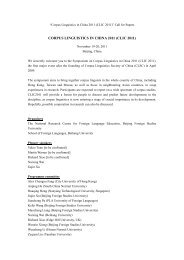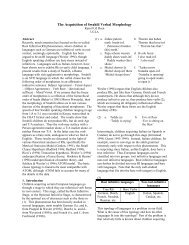The mnemonic keyword method: The effects of bidirectional retrieval ...
The mnemonic keyword method: The effects of bidirectional retrieval ...
The mnemonic keyword method: The effects of bidirectional retrieval ...
Create successful ePaper yourself
Turn your PDF publications into a flip-book with our unique Google optimized e-Paper software.
M. Wyra et al. / Learning and Instruction 17 (2007) 360e371<br />
365<br />
Table 2<br />
Variables tested on each level <strong>of</strong> the hierarchy<br />
Level Variable code Variable description<br />
Within-student OCCASION Testing occasions (0 ¼ occasion 1,., 4¼ occasion 5)<br />
LEARNING Dummy variable for learning occasion (1 ¼ occasion 2; 0 ¼ occasions 1, 3, 4 and 5)<br />
Between-student GENDER Sex <strong>of</strong> the student (0 ¼ male; 1 ¼ female)<br />
YRLEVEL Year level (0 ¼ Year 6; 1 ¼ Year 7)<br />
ACHIEV<br />
Teachers ranking <strong>of</strong> students’ academic achievement in class<br />
(1 ¼ highest achiever,., 29¼ lowest achiever)<br />
TREATMNT Treatment (0 ¼ control group; 1 ¼ experimental group)<br />
VVIQ<br />
Total score for the VVIQ questionnaire i.e. vividness <strong>of</strong> images (29 ¼ lowest,., 80¼ highest)<br />
AMI<br />
Total score for AMI questionnaire i.e. ability to make images (21 ¼ lowest,., 60¼ highest)<br />
SCHOOL1 Dummy variable for School 1 (1 ¼ School 1; 0 ¼ Schools 2 & 3)<br />
SCHOOL2 Dummy variable for School 2 (1 ¼ School 2; 0 ¼ Schools 1 & 3)<br />
SCHOOL3 Dummy variable for School 3 (1 ¼ School 3; 0 ¼ Schools 1 & 2)<br />
For parsimony, W gj in Eq. (1) represents the control for several relevant level-2 variables (W 1j þ W 2j þ . þ W gj )<br />
that describe the student characteristics, treatment and school attended by the student. Thus, W gj represents a combination<br />
<strong>of</strong> any <strong>of</strong> the nine level-2 variables listed in Table 2. <strong>The</strong> ‘u’ is the error term<br />
<strong>The</strong> first step in the multilevel analyses was to run the so-called ‘null model’ in order to estimate the amounts <strong>of</strong><br />
variance available to be explained at each level <strong>of</strong> the hierarchy (Raudenbush & Bryk, 2002). A null model contained<br />
only the dependent variable (FWR or BWR) and no predictor variables were specified at any level. <strong>The</strong> second step<br />
was to build up the Level-1 model, that is, the within-student model. This involved adding level-1 predictors to the<br />
model, but without entering predictors at the second level. An approach referred to as a ‘step-up’ approach was followed<br />
to examine which <strong>of</strong> the level-1 variables (listed in Table 2 above) had a significant influence on FWR or BWR<br />
in each <strong>of</strong> the hypothesized models. Bryk and Raudenbush (1992) have recommended the step-up approach for inclusion<br />
<strong>of</strong> variables into the model to the alternative approach referred as ‘working-backward’ where all the possible predictors<br />
are included in the model and then the non-significant variables are progressively eliminated from the model.<br />
<strong>The</strong> final step in the multilevel analyses involved building up the model to the second level through adding the<br />
significant level-2 predictor variables into the model using the step-up strategy. <strong>The</strong> final model for FWR at levels<br />
1 and 2 was<br />
Level-1 model<br />
½FWRŠ ij<br />
¼ b 0j þ b 1j ðOCCASIONÞ 1ij<br />
þ b 2j ðLEARNINGÞ 2ij<br />
þ r ij<br />
Level-2 model<br />
b 0j ¼ g 00 þ g 01 ðYRLEVELÞ 01j<br />
þ g 02 ðTREATMNTÞ 02j<br />
þ g 03 ðAMIÞ 03j<br />
þ u 0j<br />
b 1j ¼ g 10 þ g 11 ðSCHOOL2Þ 11j<br />
þ u 1j<br />
b 2j ¼ g 20 þ u 2j<br />
<strong>The</strong> final model for BWR at Levels 1 and 2 was<br />
Level-1 model<br />
ð2Þ<br />
½BWRŠ ij<br />
¼ b 0j þ b 1j ðOCCASIONÞ 1ij<br />
þ b 2j ðLEARNINGÞ 2ij<br />
þ r ij<br />
Level-2 model<br />
b 0j ¼ g 00 þ g 01 ðYRLEVELÞ 01j<br />
þ g 02 ðTREATMNTÞ 02j<br />
þ g 03 ðAMIÞ 03j<br />
þ u 0j<br />
b 1j ¼ g 10 þ g 11 ðTREATMNTÞ 11j<br />
þ g 12 ðSCHOOL2Þ 12j<br />
þ u 1j<br />
b 2j ¼ g 20 þ u 2j<br />
ð3Þ



